 W
WAn artillery tractor, also referred to as a gun tractor, is a specialized heavy-duty form of tractor unit used to tow artillery pieces of varying weights and calibres. It may be wheeled, tracked, or half-tracked.
 W
WThe AEC Matador was a heavy 4×4 truck and medium artillery tractor built by the Associated Equipment Company for British and Commonwealth forces during World War II. AEC had already built a 4×2 lorry, also known as the Matador.
 W
WThe AEC Militant was a post-war development by AEC of the AEC Matador artillery tractor used during World War II. Externally the most noticeable development was the cab, which was considerably enlarged. Unlike the Matador only 6-wheel versions were produced. 4-wheel versions are extant, but they are probably conversions and one is a Matador with a Mk1 Militant cab. Other changes included the fitting of a larger, 11.3-litre 6-cylinder, diesel engine and the use of a steel frame for the cab, rather than the ash (fraxinus) wood frame of the Matador. The Militant Mark 1 was produced in 6x4 and 6x6 form.
 W
WThe Albion CX22S was a heavy artillery tractor used by the British Army during World War II.
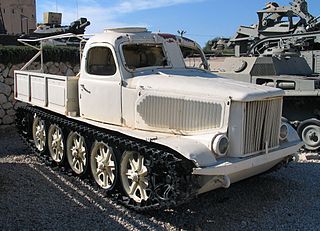 W
WArtilleriyskiy Tyagach Lyogkiy, or AT-L was a Soviet Cold War era artillery tractor.
 W
WArtilleriyskiy Tyagach Tyazholiy, or AT-T was a Soviet Cold War era artillery tractor. The AT-T is based on the chassis and drive system from the T-54 tank. However, the tub has been rotated 180 degrees, with the engine, clutch, gearbox, steering gear and the drive wheels located at the front of the vehicle. The crew cabin is also located in the front part of the vehicle, and is from the ZIS-150 and ZIL-164 trucks.
 W
WThe ATS 56 G is a Soviet artillery tractor used mainly for towing 152 mm howitzers and as an ammo transporter. It was used during the war in Vietnam.
 W
WArtilleriyskiy Tyagach Sredniy - 59, or ATS-59 was a Soviet Cold War era artillery tractor. Some models used an T-55 engine., such as the ATS-59G.
 W
WImmediately before World War I, Austro-Daimler constructed several series of the first petrol-engined four-wheel drive artillery tractors. These were some of the first commercially successful vehicles for both the Austro-Daimler company and their designer Ferdinand Porsche.
 W
WImmediately before World War I, Austro-Daimler constructed several series of the first petrol-engined four-wheel drive artillery tractors. These were some of the first commercially successful vehicles for both the Austro-Daimler company and their designer Ferdinand Porsche.
 W
WImmediately before World War I, Austro-Daimler constructed several series of the first petrol-engined four-wheel drive artillery tractors. These were some of the first commercially successful vehicles for both the Austro-Daimler company and their designer Ferdinand Porsche.
 W
WThe BAZ-6909 is a Russian artillery tractor and missile vehicle that was developed as a successor to the MAZ-537 and MAZ-7310 by Bryansk Automobile Plant. It can haul semi-trailers and loads with mass of 13-21 metric tons, both on and off road.
 W
WC2P was a Polish light artillery tractor. Designed in the 1930s, it was the basic tractor of Polish anti-aircraft artillery during the 1939 Nazi and Soviet invasion of Poland. There are only two surviving vehicles, both in private hands in Poland.
 W
WSamochód półgąsienicowy wz. 34 was a Polish halftrack lorry. It was produced in a variety of variants, the best-known of them being the C4P artillery tractor used by the Polish Army in the period before World War II.
 W
WC7P was a Polish tracked artillery tractor, used by the Polish Army before and during World War II. The tractor was developed by the design bureau of Witold Jakusz of the PZInż company between 1931 and 1934.
 W
WThe CMP FAT, was a Canadian Military Pattern vehicle manufactured by Ford and Chevrolet. The FAT was an artillery tractor of the British and Commonwealth forces during World War II. Several models were produced by the two manufactures as CGT and FGT.
 W
WThe A.15 Tank, Cruiser, Mk VI or Crusader was one of the primary British cruiser tanks during the early part of the Second World War. Over 5,000 tanks were manufactured and they made important contributions to the British victories during the North African Campaign. The Crusader tank would not see active service beyond Africa, but the chassis of the tank was modified to create anti-aircraft, fire support, observation, communication, bulldozer and recovery vehicle variants.
 W
WThe Holt tractors were a range of continuous track haulers built by the Holt Manufacturing Company, which was named after Benjamin Holt.
 W
WT-20 armored tractor Komsomolets (Bronirovannyy gusenichnyy tyagach Komsomolets T-20), an armored continuous track tractor, the T-20 was a prime mover vehicle used by the Soviet Union during the Winter War and World War II.
 W
WThe KZKT-7428 Rusich tank transporter artillery tractor was developed as a successor to the MAZ-537 by KZKT. It can haul semi-trailers loads up to 70 t, both on and off road. It entered service with the Soviet Army in 1990.
 W
WThe Laffly S15 was a family of all-terrain military vehicles from French manufacturer Laffly that shared the same six-wheel drive chassis. They were used by French forces during World War II.
 W
WThe Laffly V15T was a French light 4WD artillery tractor used during World War II. It was used to tow the 25 mm SA anti-tank gun. A personnel carrier and reconnaissance vehicle based on the same chassis was designated as V15R. The Laffly company itself only manufactured the first batch of 100 V15s, the rest of the production being taken over by Corre La Licorne.
 W
WLatil was a French automaker specializing in heavy duty vehicles, such as trucks, tractors and buses, from 1898 to 1955.
 W
WThe M4 High-Speed Tractor was an artillery tractor used by the US Army from 1943.
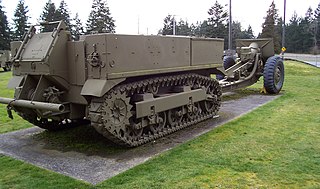 W
WThe M5 13 ton High Speed Tractor was a World War II era artillery tractor that was used by the US Army from 1942 to tow medium field artillery pieces.
 W
WThe M6 High-Speed Tractor was an artillery tractor manufactured by Allis-Chalmers and used by the US Army during World War II to tow heavy artillery pieces, such as the 8-inch Gun M1 and 240 mm howitzer M1. Its G-number was (G-184).
 W
WThe M8 High-Speed Tractor was an artillery tractor used by the US Army and Marine Corps from 1950.
 W
WThe Mack NO 7 1⁄2-ton 6x6 truck was a heavy 6x6 cargo truck designed in the 1940s by the American manufacturer Mack Trucks. It was used by the U.S. Army as an artillery tractor for heavy artillery during and after World War II. The official U.S. Army designation was: Truck, 7 1/2 ton, 6x6, Prime Mover. Its G-number was (G-532).
 W
WMAZ-535 is a Soviet army vehicle, an artillery tractor designed and developed by MAZ. Designed in the beginning of the 1950s.
 W
WThe MAZ- 537 is a 12-cylinder diesel engine-powered military truck artillery tractor, originally designed for loads up to 50 tons with later versions providing a maximum load of 65 tons. It was manufactured by the Minsk Automobile Plant and the Kurgan Wheel Tractor Plant from 1963 until halt of production in 1990.
 W
WThe Morris Commercial C8 FAT, commonly known as a Quad, is an artillery tractor used by the British and Commonwealth forces during the Second World War. It was used to tow field artillery pieces, such as the 25-pounder gun-howitzer, and anti-tank guns, such as the 17-pounder.
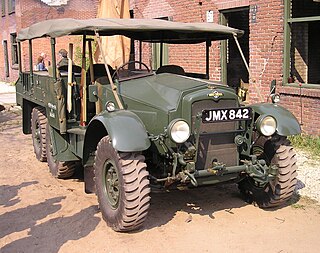 W
WThe Morris CDSW 6x4 was a six-wheeled artillery tractor brought into service in the early to mid-1930s by the British Army to tow its field guns.
 W
WMZKT-74135 is a tank transporter developed by MZKT of Belarus. It has a 796 hp engine and can tow up to 130 metric tons. The MZKT-74135 can transport either two tanks or one tank and two infantry fighting vehicles. It is all wheel drive and can travel offroad. 40 units were ordered by UAE.
 W
WThe Oxford Tracked Carrier was an early post-World War Two British armoured personnel carrier (APC) and artillery tractor.
 W
WThe P107 was a World War II French half-track.
 W
WRadschlepper Ost, literally "Wheeled Tractor East", also known as Škoda RSO or Porsche 175, was a German heavy 4WD military tractor used during World War II. It was designed by Ferdinand Porsche in 1941 and produced by Škoda in Mladá Boleslav. Around 206 vehicles were produced between the years 1942–1944.
 W
WRaupenschlepper Ost was a fully tracked, lightweight vehicle used by the Wehrmacht in World War II. It was conceived in response to the poor performance of wheeled and half-tracked vehicles in the mud and snow during the Wehrmacht's first autumn and winter on the Soviet Front.
 W
WThe S-65 tractor or Stalinets S-65 was a very popular agricultural tractor built by the Chelyabinsk Tractor Factory from 1937 until 1941. These tractors were used in military service as they were widely available and capable of towing heavy guns.
 W
WThe Scammell Pioneer was a British 6×4 tractor unit used in World War II as an artillery tractor, recovery vehicle and tank transporter.
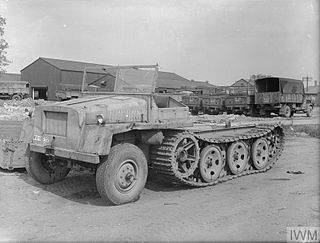 W
WThe Schwerer Wehrmachtschlepper , or sWS, was a German World War II half-track vehicle used in various roles between 1943 and 1945. The unarmored models were used as supply vehicles and as tractors to haul artillery. Armored versions mounted anti-aircraft guns or a 10 barrel rocket launcher (Nebelwerfer). Fewer than a thousand were built before the end of the war, but production continued after the war of an improved model in the Tatra plant in Czechoslovakia.
 W
WThe Sd.Kfz. 7 was a half-track military vehicle used by the German Wehrmacht Heer, Luftwaffe and Waffen-SS during the Second World War. Sd.Kfz. is an abbreviation of the German word Sonderkraftfahrzeug, "special purpose vehicle". A longer designation is Sd.Kfz. 7 mittlerer Zugkraftwagen 8t, "medium towing motor vehicle 8t".
 W
WThe Snow Trac is a small personal Snowcat that is roughly the size of a modern compact car.
 W
WThe SOMUA MCG was a half-track artillery tractor and recovery vehicle of the French forces during World War II.
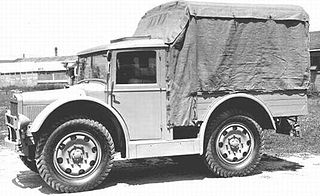 W
WThe SPA AS.37 was an Italian military light truck, used during World War II. The AS.37 Autocarro Sahariano was developed from 1937 on the frame of the TL.37 artillery tractor and was especially conceived to be employed in the North African desert. The most significant improvement of this new vehicle was its increased range: 900 km with added water tanks. The A.S.37 could transport 8 men and their equipment in its rear cargo box.
 W
WThe STZ-5 artillery tractor was a product of the Stalingrad Tractor Factory (STZ) from 1937 to 1942 in the Soviet Union. The tractor was designed to tow division to corps level guns and howitzers of 8 tonnes and less. The STZ-5 was one of the few artillery tractors specifically designed by the Soviet government for its role. With over 9900 built, it was the most-produced Soviet ‘military’ tractor during the war.
 W
WThe T-1 tractor was a project developed by the Romanian Army during World War II. A total of 1,000 were ordered. It was designed to tow a Romanian 75 mm gun. After five prototypes were produced, the project was canceled due to the lack of priority.
 W
WThe T-24 was a Soviet medium tank built in 1931. Only twenty four were built, and none saw combat. This was the first tank produced at the KhPZ factory in Kharkov, which was later responsible for the very successful BT series, T-34 and T-54 Soviet tanks. The T-24's suspension was used successfully in the Soviet Union's first purpose-built artillery tractors.
 W
WMore than 50 different modifications and experimental vehicles based on the T-26 light infantry tank chassis were developed in the USSR in the 1930s, with 23 modifications going into series production. The majority were armoured combat vehicles: flame tanks, artillery tractors, radio-controlled tanks (teletanks), military engineering vehicles, self-propelled guns and armoured personnel carriers. They were developed at the Leningrad Factory of Experimental Mechanical Engineering by talented Soviet engineers P.N. Syachentov, S.A. Ginzburg, L.S. Troyanov, N.V. Tseits, B.A. Andryhevich, M.P. Zigel and others. Many Soviet tank engineers were declared "enemies of the nation" and repressed during Stalin's Great Purge from the middle of the 1930s. As a result, work on self-propelled guns and armoured carriers ceased in the USSR during that time. T-26 light tanks were also modified into armoured combat vehicles in the field during wartime.
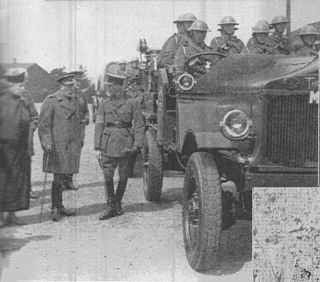 W
WThe Hathi was an early four wheel drive lorry built by Thornycroft in the 1920s. It was used by the British Army as an artillery tractor.
 W
WThe TL.37 was an Italian military artillery tractor of World War II. It was manufactured by SPA, an Italian car maker that was a subsidiary of Fiat.
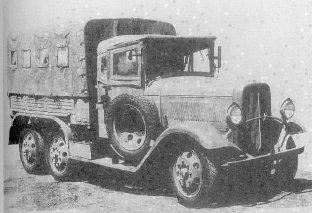 W
WThe Type 96 AA Gun Prime Mover is a Japanese 6-wheeled prime mover used during the Second World War. In entered service in 1937.
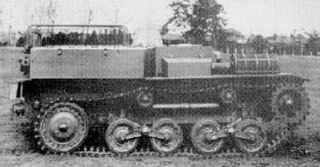 W
WThe Type 98 So-Da was an armored personnel and ammunition carrier used by the Imperial Japanese Army in World War II.
 W
WThe Universal Carrier, also known as the Bren Gun Carrier and sometimes simply the Bren Carrier from the light machine gun armament, is a common name describing a family of light armoured tracked vehicles built by Vickers-Armstrongs and other companies.
 W
WThe Vickers Light Dragon was a fully-tracked British field artillery tractor made by Vickers-Armstrongs Ltd from 1929 to 1935. Designed to tow small-calibre field guns, it complemented Vickers' Medium Dragon tractor, which pulled medium to heavy artillery.